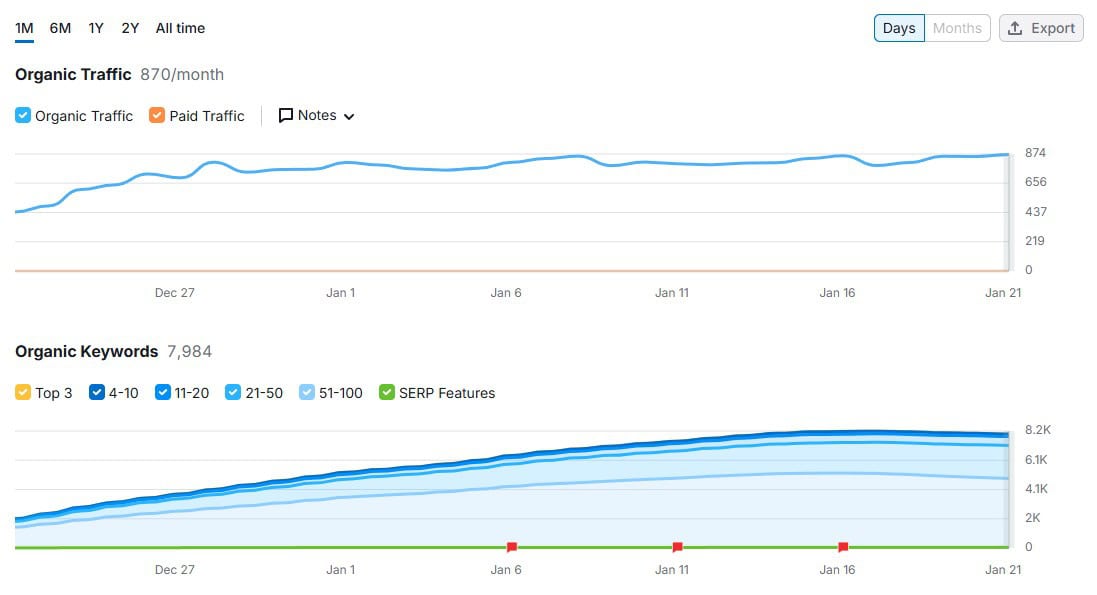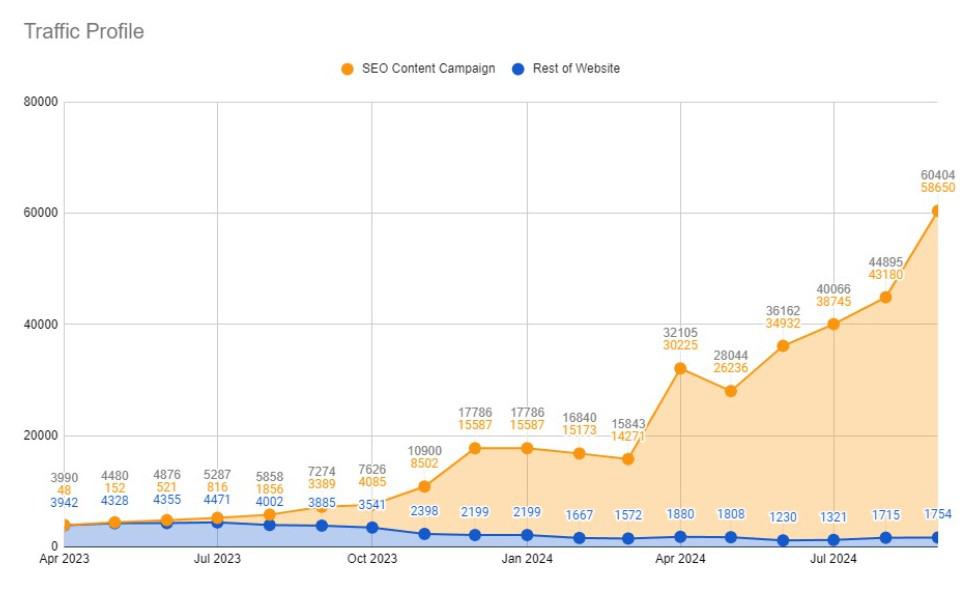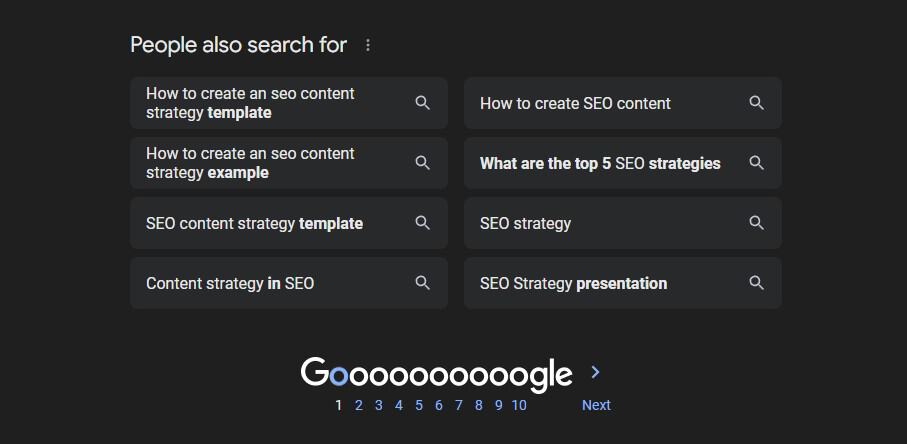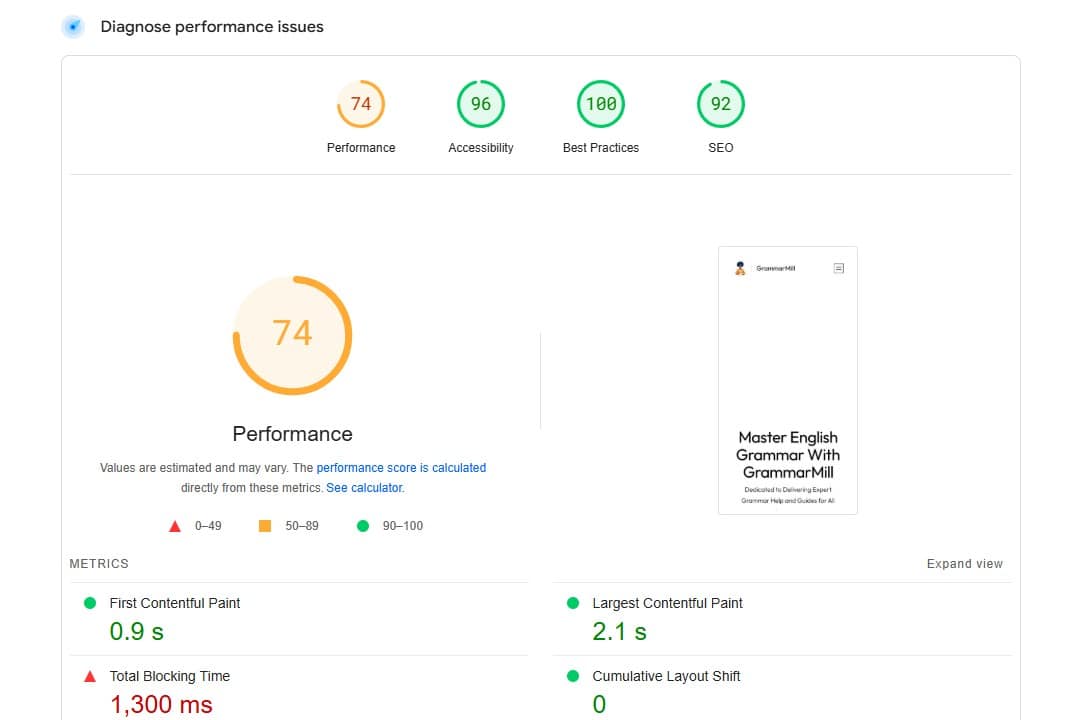
How To Create a Successful SEO Content Strategy

Are you a small business struggling to get noticed online? Creating a solid SEO content strategy is usually the first step to turning things around.
SEO (search engine optimization) boosts your website’s ranking with Google, making it easier for potential customers to find you online. It can even improve your organic CTR (click-through rate) by as much as 39.8%. This means that people will not only find your website easier but also be more likely to take action once they are there.
However, the tactics for creating a successful SEO content marketing strategy evolve over time, so you have to make sure you know what’s working now. Whether you’re designing a new content strategy for SEO or updating your previous digital marketing approach, we’ll walk you through everything your content marketing plan needs to succeed in the modern online marketing landscape.
What Is an SEO Content Strategy?

An SEO content marketing strategy combines researching, creating, optimizing and publishing strategic content on your website to rank higher on SERPs (search engine results pages). SEO content strategy starts with auditing your current website, seeing what is or isn’t working, and creating a plan to bring in more online traffic, leads and sales. The key elements of any good SEO content strategy include:
- SEO Site Audit
- Competitive Analysis
- In-depth Keyword Research
- SEO Content Creation
- On-Page Optimization / Technical SEO
- High-Quality Link Building
- Monthly Reporting/Tracking
In this blog, we’ll cover each of these elements and how you can turn them into an actionable SEO content strategy for your website.
How To Make a Content Strategy for SEO
1. Invest in an SEO Site Audit
The first thing you should do when creating an SEO content strategy is analyze the current performance of your website. How many pages are on your site? How many of those pages are ranking for keywords? How many of those keywords are actually bringing in traffic?
Without understanding how your site is currently performing on the search results, it’s hard to create a substantial plan to get you to the next level. Here is how you would perform a website audit:
Measure Overall Site Performance
Whenever we do a site content audit for clients before creating a strategy, we first look at the overall performance of the site. Namely, how many keywords does it rank for overall? How much traffic is the site bringing in on a month-to-month basis?

Here’s a quick list of what we try to glean from the website as a whole:
Age of Site
Is your site brand new? Did you just migrate it to a new domain? Has it been around for years? The age of your site and its ranking history can tell you a lot about how it might perform going forward. For instance, if the site is new and it’s not ranking, then it could be due to not having been on Google’s radar for long enough, not having enough content on the site, etc.
If your site has been around for years and has historically never ranked (but has content on the site), there may be some bigger issues (typically technical, or having to do with how your site is built) that may be the real issue instead of just not having created enough content or done enough SEO.
Site Structure
What is the hierarchy of the site? Does your website highlight its main products/services/locations? Is there any sort of structure showing the most important pages on the site with additional subpages to support them? Does your site give Google enough context as to what your company does and where it does business?
# of pages
Does the site not have very much content to begin with? Typically, sites with only a few pages rank for fewer keywords.
Total Monthly Keywords Ranking
The number of keywords on your site can be drilled down even further into keywords in the top 3 or top 10 (those ranking high enough to actually get traffic), etc. But for this exercise, just knowing the total number of keywords on your site can give you an idea of your current organic profile.
Does Google trust your site enough to rank it consistently for keywords or not? What types of keywords are you generally winning? Are you only winning branded keywords that have to do with your company name, or are you winning the types of terms people would actually search for to find a company like yours?

Total Monthly Traffic
This metric is related to monthly keywords, but it will also become the basis for all SEO content strategy efforts and tracking going forward.
Domain Authority Score
Depending on the SEO research tool you use, your Domain Authority Score will be displayed differently. Typically, it gives you a score of 1-100 (1 being the worst, 100 being the best), showing how dominant/authoritative your site is in the eyes of Google. A low domain authority score could be the reason why Google doesn’t take your site seriously, and improving it should be a key focus of your SEO content strategy.
Total Backlinks To Site
Does the site have very many backlinks coming back to it from other sites? If you have a lot of pretty good content on your site but few backlinks, that might be the missing piece to boost your site in the rankings.
Identify Performing Pages vs. Opportunity Pages
The next thing we like to separate in our SEO content audit is the performing pages from what we call “opportunity pages.” We traditionally define performing pages on your site as ones that have keywords ranking in the top 10 and are bringing in traffic. These are pretty easy to identify because they’ll come up at the top of all of your reporting from keyword research tools like Semrush, Ahrefs, or Google Analytics.
What you may not realize, though, is that these pages are also your best candidates for link building! We’ll cover this more in-depth below, but knowing which pages these are and what keywords are currently ranking on these pages is an important step in creating an effective SEO content strategy.
Opportunity pages, on the other hand, are the best-kept secret on your site. We define opportunity pages as the pages on your site that rank for multiple keywords (typically 5 to 10 or more) but that aren’t high enough to actually bring in traffic. Most small businesses don’t even consider these pages when creating an SEO strategy because they’re not super easy to identify. If pages aren’t bringing in traffic or ranking for your top keywords that you’re tracking, you’ll likely pass over them.
This is a huge mistake! Opportunity pages are those that Google has already ranked, but they just need a little work to really perform. This might come in the form of on-page SEO through an SEO content refresh, or they might also be candidates for strategic link building.
2. Conduct a Competitor Website Analysis

What’s that saying: You don’t have to outrun the bear; you just have to outrun the friend next to you? Similarly, SEO is a non-stop race, so it’s not really about “winning” anything in particular but more about continually beating out your competition. To develop a successful SEO content strategy, you need to know how fast your competitors are running online.
Look for Competitor SEO Opportunities
Using tools like Semrush, you can also quickly analyze your top competitors to see your biggest keyword opportunities (or related keywords that your competitors aren’t currently ranking for). These keywords represent potential quick wins and opportunities for deeper content creation.
Using this and any competitor audit information you find can help you reverse engineer your competitors’ strategies to rank for the keywords they’ve gotten so far. For instance, maybe they are better utilizing their main nav within their site structure to highlight their individual services (targeting specific keyword phrases on each page), or maybe they’ve created a specific location page for each of their geographical markets to capitalize on searches with local intent.
This is where you can take the best parts of your competitors’ strategies and add to or improve them for your own SEO content strategy.
Analyze 3-5 Competitors
How many competitors should you analyze? There is no hard and fast rule regarding how many competitors you should look into when creating your SEO content strategy, but a good rule of thumb is to pick at least 3. Also, if you’re in an industry that’s a little immature when it comes to SEO and online marketing, try to find some related companies that are winning keywords you would like to win so you have some good sites to emulate when it comes to creating your own SEO content strategy.
Similarly to how you ran an SEO site audit on your own website, you’d also want to conduct competitor analysis by doing an abbreviated version of the site content audit for your competitors. Creating a graph showing your site in relation to your competitors as far as domain authority, keywords ranking, total monthly traffic and total backlinks can be a nice snapshot to help you develop a plan of action to close any gaps (or capitalize on any opportunities) you find.

3. Perform In-Depth Keyword Research
Almost all good SEO content strategies start with finding the right keywords and topics for your site. From your SEO site audit and competitive analysis, you should have an idea of what keywords you’re currently ranking for and the keywords your competitors are ranking for that you would like to rank for as well. This is a great starting point to start digging into additional keyword research for your site.
Create a List of Top Keywords
When starting your keyword research for your website’s SEO content strategy, creating a list of the most impactful keywords you want to win on your site is always good practice. These keywords are the words and phrases that most accurately describe your products and services – essentially, the keywords your customers would type in to find a company exactly like yours.
We like to create a list of around 25 keyword “pillars” that represent the most important categories of keywords you want to win on your site. When creating this list of top SEO keywords for your content strategy, you’ll want to consider a few important things:
- Search Volume: The number of monthly searches this keyword gets every month. This provides some market research insight into how many people search for these terms and the potential traffic you could capture by ranking for them.
- Keyword Difficulty: This is shown on keyword research tools on a scale from 1 to 100 (1 being the easiest to win, 100 being the hardest). It gauges keywords by how many other websites are already targeting and ranking for them.
- Relevancy: How relevant are these keywords to your actual sales funnel? Will they drive leads or sales, or are the keywords too broad to deliver meaningful results?
- Intent: Does the searcher have informational, commercial or transactional intent when searching this phrase? For instance, a “How to” type keyword is informational – people are looking for how to do it. However, someone searching for “plumbing companies near me” is likely looking to make a purchase or transaction at the end of their search journey.

Consider Short-Tail vs Long-Tail Keywords
One extremely important point to keep in mind when doing keyword research for your SEO content strategy is, believe it or not, the length of the keyword phrase you’re targeting.
A short-tail keyword is typically a keyword phrase with only 1-3 words included in the phrase. This type of keyword usually has a much higher search volume and higher keyword difficulty (more competitive), but it also lacks any context as to what the searcher is actually looking for.
For instance, if you sell mountain bikes online, a short-tail keyword like “bikes” with a bazillion monthly searches might seem like a great keyword to put on your list. Outside of it being uber-competitive, though, how relevant is it to your actual customer base? What does someone searching this term actually want to know about bikes? How much they cost? How much they weigh? Different types? This short-tail keyword is likely too broad to be helpful for an effective SEO content strategy. You need an identifier that makes this keyword more specific – this is where long-tail keywords come in.
Choose Quality Over Quantity
Long-tail keywords are low-competition keyword phrases that typically have 4-7 words in them. These longer keyword phrases usually have a smaller search volume (hence why so many small businesses overlook them) and a lower keyword difficulty, but they provide you with a lot more context as to what the searcher was hoping to accomplish when typing it into Google.
This more specific phrase allows you to more accurately create content that answers users’ questions (which Google loves), is easier to win, and brings in more qualified traffic. Getting 20 people a month to your website who are actually looking to buy your product or service is worth more than 200 visits from people who aren’t actually looking to buy what you’re offering.
Use SEO Tools for Deeper Research & Strategy
If you’re serious about creating a successful SEO content strategy, start using SEO keyword research software to find topics, information on your competition, and long-tail keywords more quickly. We’re fans of Semrush here at BKA Content. With it, you can audit your site, research appropriate topics and keywords, and get insights into site traffic. Semrush, in our opinion, has the most accurate keyword data for site content and allows you to track keyword momentum on your site.
If you’re not ready to invest in an advanced keyword research tool from the likes of Semrush or Ahrefs, you can start with free tools like Google Keyword Planner.
Another option is to invest in a proven SEO company (like us!) that has a track record of using SEO content strategies to rank on Google. Whatever you decide, just start finding ways to automate your process sooner rather than later because your competitors who are ranking already are, and you’ll need that to keep up.
Boost Your SEO Content Strategy With BKA
Ready to step up your SEO game? Contact BKA Content today for a FREE SEO audit and consultation to help you start creating customized SEO strategies that deliver results!
4. Create SEO Content
Once you’ve completed your site content audit, analyzed competitors and done some in-depth keyword research for your site, it’s time to start creating content! While there are lots of types of content that you could create as a part of an SEO content strategy, the most impactful pieces of content for ranking usually include web pages (main nav pages/service pages/industry pages/category pages) and blog posts.
Focus on Strategic Web Page Creation First
If it has become clear that your main site structure is missing some critical web pages that would help to expand your main keyword base on your site, this would be the first place to start. Some examples of these SEO-rich types of web pages based around keywords may include:
- Main Service Pages: These are typically found in your main nav under the “Services” tab. For instance, if you’re an HVAC service provider that does heating, air, electrical, plumbing and more, you’ll want to at least make sure you have individual web pages dedicated to each of those services – with each of those pages built around a keyword subset you found in your research (e.g., “affordable electrical services”). If you’re only operating locally, not nationally, you’ll want to make sure you infuse each of these pages with a list of the locations you service so you’re providing context to Google that you perform all of those services in each of those areas.
- Location Pages: If you operate nationally, you can probably skip this point unless certain markets are more profitable than others and you have search volume for keywords with local intent that would be worth making individual pages for. But for companies that operate locally, it’s a huge SEO content strategy opportunity to make Location Pages that target each of the nearby markets around you (e.g., “HVAC services in Denver”). Think of these as mini-home pages that are dedicated to your main service offering + the geographic location.
- Industry Pages: If you own a B2B business, then making web pages for each of the different industries you target is another way to capitalize on low-hanging keywords that you can win on your site. An example of this would be making a “marketing for dentists” page along with a “marketing for lawyers” type page that caters your service offerings to that individual industry.
This isn’t an exhaustive list of the pages to put on your site in order to have a successful SEO content strategy – your keyword research will help to drive what pages you should make. In some instances, there may be enough keyword search volume for keywords that you can effectively create another layer of pages under the ones listed above.
For instance, if there’s enough search volume for a single one of your services in multiple local markets, you may make both a “heating services in Denver” page and an “AC services in Denver” page, etc. If you have a lot of opportunity at a local level, there are other Local SEO strategies you could also employ, such as citation updating/management, GBP (Google Business Profile) weekly updates, etc.
Here is a quick example of a “Location Page” targeting “Utah SEO Company” (and similar keywords) on our site:

Although we service small businesses nationally and internationally, we’re physically located in Utah, and there’s a decent amount of search volume for SEO keywords related to Utah specifically, so we have a small local campaign for our home state built out through our web pages.
Use Blog Posts as an Ongoing Way To Win New Keywords
A blog is essential for an SEO content strategy because it gives you a place on your site where you can regularly put up fresh content, allowing you to endlessly target new keywords and bring in new traffic. Did you know that small businesses that blog consistently (think 4-16 times a month) are 13 times more likely to achieve a positive ROI than sites that do not? Or that businesses with blogs get 55% more visitors than those that don’t?
Your blog can be an extremely powerful driving force in your SEO content strategy if utilized correctly. Here is one case study of a plastic surgery clinic client we primarily did SEO blog writing services for that saw huge traffic growth (almost 15X what it was to begin with) over the course of 12-18 months of consistent blogging:

Some common types of informational content you could include on your blog are:
- How-Tos
- Listicles
- In-depth guides (This blog would fall under this category)
- Frequently Asked Questions
If you have the right pillar pages on your website covering some of the top keyword phrases you discovered in your initial research, you’ll be much better set up to build out a blog that can perform right out of the gate.
Having pillar pages in place allows you to target long-tail, informational keywords in your blog that are related to the top keyword categories you have in your main web pages. This allows you to win specific keywords with each blog post as well as boost those other main pages on your site (that have commercial-intent keywords) through an internal linking structure.
Optimize Your Content for SEO
Just creating content is one thing, but creating strategically optimized SEO content that ranks and matches user intent is something completely different. If you’ve picked great long-tail keywords that give you a lot of context on what the user is searching for, then creating a blog topic, title and outline becomes much easier.
You should always take the keyword phrase you’re targeting, throw it into Google (in incognito mode so it doesn’t show your previous search biases) and see what some of the top results on Google are and the types of things they cover in those pages. Seeing the topics that your competition is writing about (and getting top ranking for) is a great place to start when building out your SEO content brief.
From there, look at some of the “People also search for:” questions at the bottom of the search engine result page that are related to your main keyword phrase to get additional context that you could add to your piece.

Once you have a brief that will keep your article on point, it’s time to begin the writing process. There’s a LOT that goes into writing great SEO content. This is true no matter if you’re writing it yourself or using an AI-writing tool to help draft the foundation of your content.
When creating content for your SEO strategy, make sure you focus first on answering the keyword query, providing value and building some additional context by using variations of your keyword or an additional set of keywords that reinforce the primary.
Insert Keywords Strategically
When it comes to the actual SEO optimization of keywords in your content, where you put keywords matters. Some important places to put keywords in your content for SEO include:
- Page URL
- Meta Description
- Title Tag
- Image Alt Text
- Page Title (H1)
- Additional Headings (H2s and H3s)
- First and last paragraph (intro and conclusion)
- Evenly throughout (every 100-200 words or so – don’t keyword stuff!)
If, during the content writing and optimization process, it ever comes down to deciding between placing a keyword and having the piece read naturally, always choose readability. Google is smart enough to crawl the entire article you wrote and fill in some of the blanks even if you didn’t get your exact keyword phrase in the content as many times as you’d hoped.
5. Refresh Existing Pages With On-Page SEO

Outside of just creating new web pages and building out a blogging strategy, a successful SEO content strategy should also factor in on-page SEO work as well. You can (and should) breathe new life into pages that may have been derailed by poor initial keyword optimization or a mismatch of content on the page. By actively cleaning up small page issues and continually improving content with small on-page SEO tweaks, you can generate big results.
Consider Technical SEO
Technical SEO is a broad term that can cover almost everything related to a website, but we’ll keep this simple within the context of an SEO content marketing strategy. For our purposes, technical SEO would be things like page speed, broken links and using proper html formatting and meta tags on pages.
If you want an easy way to check page speed for technical SEO purposes, go to pagespeed.web.dev and enter in your page URL. This free tool will quickly give you some page speed metrics it’s running the page against to see if your images are too large (which take extra time to load), time to first byte, etc. Scroll down a little bit to see performance issues and get a score. While there are a million ways to address page speed, one of the easiest is to get a caching plugin like WProcket.

Outside of overall page speed (see above – get a caching plugin!) and 404s coming up on major pages of your website that you know should exist, technical SEO usually encompasses the small, back-end details of your site that can send signals to Google about ranking your content – either good or bad.
For instance, using headings in your content writing is a form of technical SEO. The HTML tags surrounding the heading formatting indicate to Google that this piece of content umbrellas content underneath it, thereby telling Google to weigh the words in that text more than, say, paragraph text. This is why headings are such an important piece of SEO real estate when it comes to inserting and optimizing keywords.
On the flip side, if you’re using the H1 formatting just to change the appearance of the text to make it look a little bigger than paragraph text, and you use it on multiple headings within your content, you’re on the fast track to tanking your technical SEO and ruining rankings.
Refresh and Re-Optimize Existing Content Around Ranking Keywords
In a perfect world, every piece of content in your SEO strategy would rank well and for the exact keyword you had in mind. Unfortunately, that’s not usually the case. Pages on your site should be looked at as living, breathing website assets that can be improved continually in order to maximize their ROI.
Sometimes, you’ll create content with the goal of ranking for a specific keyword subset, but when you check back a few months later, you’ll notice it’s ranking – just not for the keywords you originally targeted.
All is not lost! The fact that the content ranks at all is a testament to Google seeing something valuable on that page. These are those “opportunity pages” we talked about earlier.
Analyzing your content and seeing which keywords it’s currently ranking for can help you see what Google thinks your piece is all about. At that point, you may just need to re-optimize your content around the currently ranking keywords (and add/change/refresh SEO content to better support it), then you may start to see some major results fairly quickly.
6. Engage in High-Quality Link Building Campaigns

When used correctly in an SEO content strategy, link building can provide a massive boost to already-ranking pieces of content. This is one of the best SEO tools you have in your tool bag to make a difference on key terms that are hard to rank for with just content alone.
Decide How Many Backlinks You Need
There is a long-standing debate in the SEO industry about whether having lots of backlinks matters more than the quality of the backlink. The truth is, the number and type of backlinks you need for your SEO strategy depend on who your competitors are and what it takes to outperform them.
Finding out how many backlinks you need starts by comparing your page ranking for the keyword you’re trying to boost with said backlinks against the other pages currently winning the top spots for that keyword. For good measure, take the page URLs of the top 3-5 legit business website pages ranking (you can ignore Reddit and sponsored ads). First, check the number of backlinks pointing to each of those pages.
If your competitors have more links than you, then it’s logical to surmise that you need to have at least as many links as (if not more than) your competitors in order to beat them out of the top 5 spots. While that little math exercise is all well and good, the truth is that finding the number of backlinks isn’t quite that easy because not all backlinks are created equal.

Consider the Quality of the Backlink
Next, use whatever SEO tool you have (both Semrush and Ahrefs have backlink analytics features), and see what the domain authority scores are for the sites linking to your competitors. If your competitors have better links going back to their sites (meaning they come from a site with higher domain authority), then just getting X number of links to match their total likely won’t do the trick. You need to make up the difference with links that have an equal or better quality than the links going to your competitors.
If you’re in an industry that doesn’t typically engage in aggressive online marketing strategies, then simple, relatively cheap backlinks from websites with a lower domain authority score will likely be enough to move the needle. If you’re in a more competitive online space, then you may end up spending way more money on cheap backlinks to try to match the efficacy of a single, high-quality backlink from a domain with a high authority score. Custom, high-quality links have more staying power, can have a greater influence on swaying Google, and usually come from more relevant, authoritative sites than cheaper backlinks.
If you have the budget, then high-quality backlinks are definitely the better bet and help to future-proof you from upstart competitors. However, the analysis on whether to use cheaper links vs. more expensive, high-quality links in your content strategy can even be done on a page-by-page, keyword-by-keyword basis to make the best use of your budget.
Use Link Building as a Catalyst, Not a Crutch
The one caveat is that engaging in link building at the exact same time as building new content (i.e., sending links to a brand new piece of content that doesn’t rank for anything yet) removes your ability to track how good the content is. If you end up ranking for keywords with this piece of content that you wrote and quickly attribute links to, you won’t know whether you’re ranking because you had really good content that was optimized correctly and answered the user query or because of the quality of the backlinks.
In our experience, it’s always best to create the content first, let Google tell you it’s valuable by how it ranks, and then use link building as a catalyst to raise the rankings of those high-value search terms you’re targeting. Whenever we’ve employed custom, high-quality link building like this in our SEO strategies, we’ve seen keyword rankings skyrocket as a result.
Here’s an example of how link building affected one of our attorney clients who used our law firm SEO services. We had been writing content for this client for 6 months before applying links, and in May-Jun of that year, we started a link-building campaign of 10 high-quality backlinks a month. Here are the results:

You can see that this attorney’s website traffic went from 2000 visits a month to over 12,000 just from the backlinking effect. Where high-quality backlinks don’t come cheap, proving your content is worthwhile before making an investment is a prudent way to maximize your link-building expenses.
7. Measure and Track Your Success
Lastly, and maybe most importantly, a content strategy for SEO is only as good as the reporting you do on it. If you don’t know what’s moving the needle for your site from your SEO efforts, how can you replicate it? You should monitor your SEO efforts to see what works and what you need to improve. Tools such as Google Analytics, Semrush, Moz, and Ahrefs can help you track your key metrics, including bounce rate, organic traffic, and keyword rankings.
Make a Content Calendar
In addition to some of the fancier SEO tools out there, using an internal content calendar can be a great way to segment your SEO content campaigns for proper tracking. Not only that, consistency is key to keeping your audience engaged and improving your SEO, and a content calendar can keep your publishing on track.
You may include blog writing, new web page creation, link building and on-page SEO on this calendar to see the deliverables each month. Set realistic goals for your team and establish accountability measures to stick to a regular posting schedule. It may feel like you need fancy software or tools in order to create a good content calendar, but a shared Google sheet will do just fine (even if it is made by AI).

Monitor Individual SEO Campaigns
We also suggest measuring and tracking each of your SEO campaigns individually. If you have a content calendar, you could make a tab on each spreadsheet with the URLs of the content published for those campaigns. When you run reports in Semrush, Google Analytics or Ahrefs, you can pair it with your spreadsheet to see how each of those website pages is performing. Track metrics such as the number of keywords ranking overall, the number of keywords ranking in the top 3 positions and top 10 positions, etc. You can also see total traffic going to those pages, including organic-only traffic, direct traffic and referral traffic.
One use case of this segmented reporting is if you’re writing SEO blogs every month, you should track your blogs, the keywords and traffic they are bringing in separately from the new web pages you just built, or the existing pages you just refreshed and re-optimized. This will help you to know where you’re getting the most bang for your SEO buck. Sometimes, certain industries will do better with blogging, whereas others see the biggest return from link building or on-page SEO.
Without being able to see the progress you’re making on your SEO content strategies, you won’t be able to make informed decisions about where to put your online marketing budget. It might also help to get an SEO consultation from an expert to make sure you understand what’s making the biggest impact on your site.
Develop a Strong SEO Content Strategy, Get Results
A comprehensive SEO content strategy is essential for standing out online. With a solid plan, you’ll start to see real SEO results as you work your way to the top of Google.
Need help getting started? If you’re looking for DIY SEO help, head on over to our SKOOL SEO community (It’s FREE!) to rub shoulders with like minded business owners looking to learn more about how to do SEO and optimized for AI search. We’ve got free SEO tutorials (as well as paid expert tutorials) to help you get what you need to succeed.
If you’re ready to supercharge your search rankings, then contact BKA Content today for a free SEO audit, an SEO analysis & action plan, expert guidance and top-notch SEO content services. Let’s boost your online presence together!
- The 10 Best Digital Marketing Agencies In Utah: 2026 List - January 6, 2026
- The 7 Best Affordable Local SEO Services in 2026 - January 5, 2026
- The 7 Best SEO Packages To Help Your Business in 2026 - January 4, 2026


